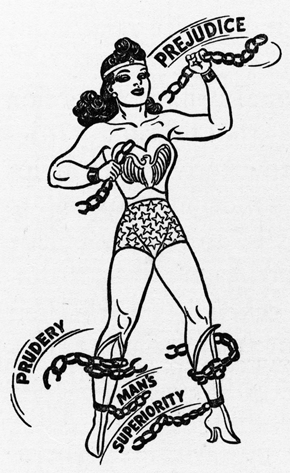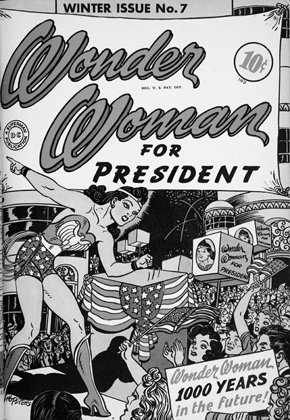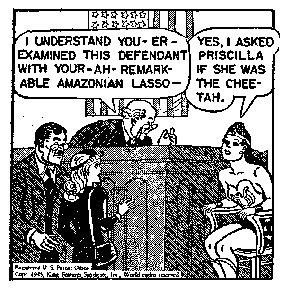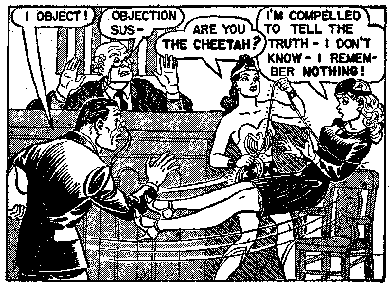Wonder Woman for President!
by Jill Lepore
“Jill Lepore reveals that the life of the character’s creator was waaay more colorful than any comic-book superhero. Suffering Sappho!” Art Spiegelman
By the beginning of 1972, when the editors of Ms. were planning the magazine’s first regular issue, the women’s movement seemed on the verge of lasting, breathtaking success. In January, Shirley Chisholm announced that she was running for president, seeking the Democratic Party’s nomination. In March, the Equal Rights Amendment, first introduced to Congress in 1923, passed the Senate. In June, Richard Nixon signed into law Title IX, ensuring that “no person in the United States shall, on the basis of sex, be excluded from participation in, be denied the benefits of, or be subjected to discrimination under any education program or activity receiving federal financial assistance.” Nineteen seventy-two was a legislative watershed. “We put sex discrimination provisions into everything,” Bella Abzug said. “There was no opposition. Who’d be against equal rights for women?”
When the July 1972 issue of Ms. appeared on newsstands in June, Chisholm was still in the race. She didn’t concede the nomination to George McGovern until the Democratic National Convention, held in Miami the second week of July. Even as delegates made their way to Florida, they saw, in airports, on the cover of Ms., the drawing Holloway saw when she visited the magazine’s offices: a giant Wonder Woman striding across a city beneath a banner reading, “WONDER WOMAN FOR PRESIDENT.” In running it, Ms.’s editors were attempting to stake out political terrain: theirs would be a magazine of politics. They also wanted to bridge the distance between the feminism of the 1910s and the feminism of the 1970s with the Wonder Woman of the 1940s, the feminism of their childhood.
“Looking back now at these Wonder Woman stories from the ’40s,” Gloria Steinem said, “I am amazed by the strength of their feminist message.” Steinem, born in Ohio in 1934, had loved the original Wonder Woman as a girl. She’d also had something to do with comics as a grown-up. In the 1960s, while working for Harvey Kurtzman, who’d helped William Gaines create Mad, she’d gotten to know Dorothy Roubicek Woolfolk, who’d returned to DC Comics to edit a line of romance comics. For the July 1972 issue of Ms., Steinem was supposed to write both the cover story about Wonder Woman and a feature story about women voters. She handed the cover story over to Joanne Edgar. Edgar, born in Baton Rouge in 1943, grew up reading comics, too. The kids on her street, mostly boys, used to stack their comic books up and down the sidewalk, for trading. For one Superman, Edgar could get three issues of Wonder Woman.
“Wonder Woman had feminist beginnings, but like many of us, she went into a decline in the ‘fifties,’” Edgar explained in her cover story.
[Creator William Moulton] Marston died in 1947, but Wonder Woman lived on. The new writers didn’t understand her spirit, however, and she lost some of her original feminist orientation. Her superhuman strength remained, but her violence increased. Rather than proving her superiority over men, she became more and more submissive.
Edgar, like Steinem, was troubled that, beginning in 1968 – during what is known as the ‘Diana Prince Era’, when she wasn’t even called Wonder Woman anymore – Wonder Woman had lost both her costume and her superpowers. But, according to Edgar, with a renewed women’s rights movement, all this was about to change. In 1971, DC Comics named Roubicek Woolfolk as Wonder Woman’s new editor, and Edgar reported that she planned to bring back Marston’s Wonder Woman: “Ms. Woolfolk also plans to decrease violence in the plots and return our heroine to the feminism of her birth. And maybe to politics, too?”
The founders of Ms. placed great faith in Wonder Woman’s ability to launch the magazine. The July 1972 issue featured not only “wonder woman for president” on the cover and Edgar’s article inside but also a four-page pullout, a reproduction of ‘Introducing Wonder Woman’ from the December 1941–January 1942 issue of All-Star Comics. Steinem, Edgar and Carbine also decided to publish a stand-alone anthology of Wonder Woman comics from the 1940s as a way to build publicity and gain subscribers for Ms. Steinem picked out which of Marston’s original stories to include, steering clear of the bondage theme as best she could.1 Wonder Woman: A “Ms.” Book, appeared in the summer of 1972 as a Ms. publication, distributed by Warner. “The Ms. cover story on Wonder Woman in July, 1972, brought so many requests for these vintage and out-of-print stories, that they have been collected in one irresistible book,” the magazine’s editors claimed. (This was disingenuous; the book had been typeset even before the first issue of the magazine was printed.) Profits went to the magazine; order forms encouraged fans of Wonder Woman to subscribe to Ms.
“Lovely and Wise Heroine Summoned to Help the Feminist Cause,” the New York Times announced. The Los Angeles Times declared Wonder Woman “The Movement’s Fantasy Figure.” In November 1972, during the week of the presidential election, wire-service stories about the return of Wonder Woman were published all over the country. By May 1973, Ms. and Warner were wondering, together, whether they might manufacture and market a Wonder Woman doll. In July 1973, a women’s health collective in Los Angeles featured Wonder Woman wielding a speculum on the cover of a newsletter dedicated to teaching women how to conduct their own vaginal exams.
In 1973, the year Wonder Woman was named a “symbol of feminist revolt”, the Supreme Court issued a ruling legalizing abortion. But the aftermath of Roe v. Wade didn’t bolster the feminist movement; instead, it narrowed it. If 1972 was a legislative watershed, 1973 marked the beginning of a drought. Some gains were lost; others proved illusory. Even the idea that DC Comics was hiring Dorothy Roubicek Woolfolk to edit a new Wonder Woman comic book and “return our heroine to the feminism of her birth” turned out to be wrong.
Gloria Steinem saw some of the Diana Prince Era issues and said, ‘What’s happened to Wonder Woman? You’ve taken away all her super-powers. Don’t you realize how important this is to the young women of America?’”
Dorothy Roubicek Woolfolk did edit one issue of Wonder Woman in 1971, and another early in 1972; those issues are no different from any published during the Diana Prince Era. About that time, Steinem, visiting DC Comics to pick out old Wonder Woman stories to reprint in the Wonder Woman Ms. book, saw some of the Diana Prince Era issues and said, “What’s happened to Wonder Woman? You’ve taken away all her super-powers. Don’t you realize how important this is to the young women of America?” Roubicek Woolfolk sided with Steinem – she wanted Wonder Woman to get her superpowers back – for which she was fired, right about when the July 1972 issue of Ms. appeared on newsstands.
Roubicek Woolfolk had no hand in it, but in December 1972, DC Comics published a ‘Special! Women’s Lib Issue’ of Wonder Woman, edited by Dennis O’Neil and written by a science-fiction writer named Samuel R. Delany. It was meant to be the first installment of a six-part storyline; in each installment, Diana Prince was supposed to battle a male chauvinist. In the first story (a recycling of a story from the 1940s), Diana defeats a department store owner who is underpaying women workers. “Another villain was a college advisor who really felt a woman’s place was in the home,” Delany later explained. “It worked up to a gang of male thugs trying to squash an abortion clinic staffed by women surgeons.” The abortion clinic story was killed. Only the first of Delany’s six ‘women’s lib’ stories was ever published.
The comic-book industry found it nearly impossible to respond to the women’s movement. In 1972 and 1973, Marvel Comics, keen to hitch its wagon to the women’s movement, produced three ‘women’s comics’ – Night Nurse, Shanna the She-Devil and The Cat; all failed after fewer than half a dozen issues. DC Comics abandoned Delany’s Diana Prince stories. Instead, in early 1973, Wonder Woman returned, in costume and with all her superpowers restored, in DC’s ‘New Adventures of the Original Wonder Woman’, written and edited by Robert Kanigher, who, to say the least, wasn’t known for his sympathy with the women’s movement. (“Bob Kanigher was a very wild chauvinist,” his assistant later said.) The first thing Kanigher did in ‘New Adventures’ was to have a barely fictionalized Dorothy Roubicek Woolfolk murdered. A panel pictures her dead at her desk, slumped over a typewriter. The caption reads: “The sniper’s first bullet fells Dottie Cottonman, woman’s magazine, editor.”
…
“Who’d be against equal rights for women?” Bella Abzug asked in 1972. A lot of people. In the late 1970s and 1980s, the women’s movement stalled. Wages never reached parity; social and economic gains were rolled back; political and legal victories seemingly within sight were never achieved. Then, too, feminists were divided, radicals attacking liberals and liberals attacking radicals in a phenomenon so widespread it even had a name: ‘trashing’. As early as 1970, the founder of the New Feminist Theater warned, in a letter of resignation from the Congress to Unite Women, that feminist “rage, masquerading as a pseudo-egalitarian radicalism” was becoming “frighteningly vicious anti-intellectual fascism.”
In that battle Wonder Woman wasn’t caught in the crossfire; Wonder Woman was the ammunition. In 1967, William Dozier, who’d launched a Batman TV series on ABC in 1966, filmed a screen test for a super-campy Wonder Woman series called Who’s Afraid of Diana Prince?; the show was never produced. But Ms.’s revival of Wonder Woman made ABC take another look. In March 1974, Cathy Lee Crosby starred in an ABC-TV Wonder Woman movie. It had little to do with the 1940s Wonder Woman; it was set in the 1970s, and it was a flop. But the next year, ABC launched The New Original Wonder Woman. Set in the 1940s, it was based very closely on Marston’s comics, as was its theme song:
Wonder Woman! Wonder Woman!
All the world is waiting for you
And the power you possess.
In your satin tights,
Fighting for your rights,
And the old red, white, and blue.
Wonder Woman! Wonder Woman!
Now the world is ready for you,
And the wonders you can do:
Make a hawk a dove,
Stop a war with love,
Make a liar tell the truth.
Wonder Woman!
Get us out from under, Wonder Woman!
All our hopes are pinned upon you!
The New Original Wonder Woman ran for four years. To radical feminists, it looked like a sellout of everything the feminist movement stood for. In 1968, the Redstockings of the Women’s Liberation Movement had protested the Miss America pageant in Atlantic City, chucking high heels and issues of Playboy into a Freedom Trash Can and crowning, as Miss America, a sheep. The star of The New Original Wonder Woman was Lynda Carter, a beauty pageant winner who’d represented the United States in the Miss World contest in 1972. But the battle over Wonder Woman predated Carter’s debut as Wonder Woman. As early as July 1972, Betty Friedan distanced herself from Gloria Steinem by accusing her of telling women they had to be ‘superwomen’.

Harry G. Peter, pen and ink drawing from Marston’s ‘Why 100,000 Americans Read Comics’, American Scholar 13, 1943–44. The Harvard College Library
In May 1975, six months before ABC aired its pilot starring Carter, the Redstockings held a press conference to announce the release of a sixteen-page report. It purported to prove (1) that Gloria Steinem was a CIA agent; (2) that Ms. was both a capitalist manifesto and part of a CIA strategy to destroy the women’s movement; and (3) that Wonder Woman was a symbol of the ruination of feminism. The report, printed as a broadside, was illustrated by a drawing of Wonder Woman with Steinem’s head. The Redstockings indicted Ms. for its relationship with Warner Communications, citing the terms of the original deal – in which Warner provided most of the funding but was not a majority stockholder – and asking, “What possible interest could this mammoth conglomerate have in women’s liberation that would lead them to agree to such unbusiness-like terms?” The Redstockings wanted to know: Why would Warner spend a million dollars to fund a feminist magazine, unless it was part of a secret plan to sabotage the feminist movement? Even the fact that Diana Prince is “an army intelligence officer” seemed to the Redstockings to be evidence that Steinem was a CIA puppet, a willing and knowing participant in a conspiracy to destroy the women’s liberation movement. Furthermore: “Wonder Woman also reflects the anti-people attitude of the ‘liberal feminists’ and the matriarchists who look to mythical and supernatural heroines and ‘models’ while ignoring or denigrating the achievements and struggles of down-to-earth women. It leads to the ‘liberated woman’, individualist line that denies the need for a movement, and implies that when women don’t make it, it’s their own fault.”
Steinem rebutted each of these charges. “It’s really crazy, isn’t it?” Edgar wrote to the head of Warner, enclosing the Redstockings’ statement. But this rift, like so many others, proved impossible to close. And, while the Redstockings’ conspiracy theory really was crazy, they did have a point about Wonder Woman. Who needs consciousness-raising and equal pay when you’re an Amazon with an invisible plane?
1 As Karen Walowit wrote, regarding the Ms. anthology, “That the editors could have managed to find twelve stories which avoid the issues of dominance and submission (often depicted in the comics as slavery and bondage) is in itself a tour de force, but misrepresents the pervasiveness of these concepts in the original Wonder Woman.”
This is an edited extract from The Secret History of Wonder Woman, out now in hardback and eBook.
 Jill Lepore is a professor of American history at Harvard University and a staff writer at The New Yorker. She lives in Cambridge, Massachusetts. Her books include Book of Ages, a finalist for the National Book Award; New York Burning, a finalist for the Pulitzer Prize; The Name of War, winner of the Bancroft Prize; and The Mansion of Happiness, which was shortlisted for the 2013 Andrew Carnegie Medal for Excellence in Nonfiction. During a Guggenheim Fellowship year beginning in 2015, she will be working on Dickens in America, an account of the novelist’s 1842 American tour. The Secret History of Wonder Woman is published in the UK by Scribe.
Jill Lepore is a professor of American history at Harvard University and a staff writer at The New Yorker. She lives in Cambridge, Massachusetts. Her books include Book of Ages, a finalist for the National Book Award; New York Burning, a finalist for the Pulitzer Prize; The Name of War, winner of the Bancroft Prize; and The Mansion of Happiness, which was shortlisted for the 2013 Andrew Carnegie Medal for Excellence in Nonfiction. During a Guggenheim Fellowship year beginning in 2015, she will be working on Dickens in America, an account of the novelist’s 1842 American tour. The Secret History of Wonder Woman is published in the UK by Scribe.
Read more
Author portrait © Dari Michele




